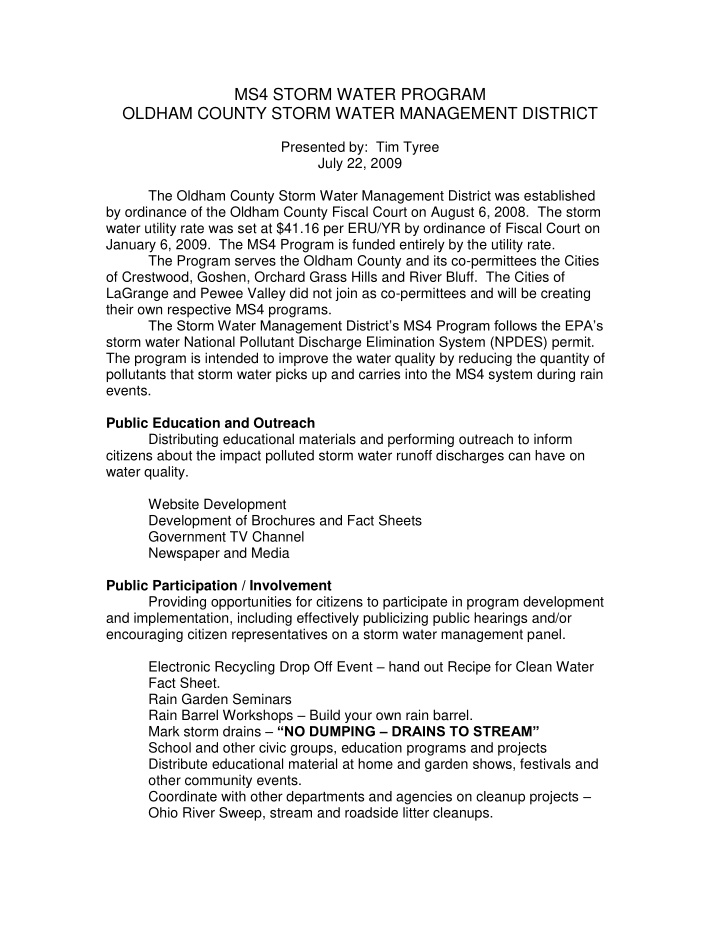



MS4 STORM WATER PROGRAM OLDHAM COUNTY STORM WATER MANAGEMENT DISTRICT Presented by: Tim Tyree July 22, 2009 The Oldham County Storm Water Management District was established by ordinance of the Oldham County Fiscal Court on August 6, 2008. The storm water utility rate was set at $41.16 per ERU/YR by ordinance of Fiscal Court on January 6, 2009. The MS4 Program is funded entirely by the utility rate. The Program serves the Oldham County and its co-permittees the Cities of Crestwood, Goshen, Orchard Grass Hills and River Bluff. The Cities of LaGrange and Pewee Valley did not join as co-permittees and will be creating their own respective MS4 programs. The Storm Water Management District’s MS4 Program follows the EPA’s storm water National Pollutant Discharge Elimination System (NPDES) permit. The program is intended to improve the water quality by reducing the quantity of pollutants that storm water picks up and carries into the MS4 system during rain events. Public Education and Outreach Distributing educational materials and performing outreach to inform citizens about the impact polluted storm water runoff discharges can have on water quality. Website Development Development of Brochures and Fact Sheets Government TV Channel Newspaper and Media Public Participation / Involvement Providing opportunities for citizens to participate in program development and implementation, including effectively publicizing public hearings and/or encouraging citizen representatives on a storm water management panel. Electronic Recycling Drop Off Event – hand out Recipe for Clean Water Fact Sheet. Rain Garden Seminars Rain Barrel Workshops – Build your own rain barrel. Mark storm drains – “NO DUMPING – DRAINS TO STREAM” School and other civic groups, education programs and projects Distribute educational material at home and garden shows, festivals and other community events. Coordinate with other departments and agencies on cleanup projects – Ohio River Sweep, stream and roadside litter cleanups.
Illicit Discharge Detection and Elimination Developing and implementing a plan to detect and eliminate illicit discharges to the storm sewer system (includes developing a system map and informing the community about hazards associated with illegal discharges and improper disposal of waste). Educate staff and other public employees, businesses and public on hazards associated with illegal discharges and improper disposal of waste. Create “HOT LINE” to report discharges or dumping of wastes into the storm water system or streams. Construction Site Runoff Control Developing, implementing, and enforcing an erosion and sediment control program for construction activities that disturb one or more acres of land (controls could include silt fences and temporary storm water detention ponds). Site inspection and enforcement of erosion control measures. Review of construction site plans that consider water quality impacts to include standards and specifications. Develop procedures for service request monitoring system for inspection staff. Track developments to include construction, inspection, compliance and enforcement on projects. Develop certification program for contractors and developers. Create a BMP Award to highlight developers who are on the right track and maintaining their properties. Post-Construction Runoff Control Developing, implementing, and enforcing a program to address discharges of post-construction storm water runoff from new development and redevelopment areas. Applicable controls could include preventative actions such as protecting sensitive areas (e.g., wetlands) or the use of structural Best Management Practices (BMPs) such as grassed swales or porous pavement. Utilize existing Post-Construction Ordinance. Develop and implement programs using structural and non- structural BMP’s to improve water quality. Establish appropriate long- term maintenance and operation of the BMP’s. Pollution Prevention / Good Housekeeping Developing and implementing a program with the goal of preventing or reducing pollutant runoff from municipal operations. The program must include municipal staff training on pollution prevention measures and techniques (e.g., regular street sweeping, reduction in the use of pesticides or street salt, or frequent catch-basin cleaning).
Develop infrastructure inventory from GIS data, establish a maintenance schedule to address needed repair or replacement. Develop and implement an operation and maintenance program with the goal of reducing pr preventing pollutant runoff from municipal operations into the storm sewer system. Funding Sources Grants or low interest government loans for improvement projects. Watershed Plan Engagement Opportunities Education – provide educational material, help with distribution of same. Identificat ion of BMP’s and help with the implementation of same. Partner with Watershed Team and other agencies to help improve the water quality of the Curry’s Fork Watershed. Resources www.oldhamcounty.net Contact Information Tim Tyree Oldham County Storm Water Manager Oldham County Storm Water Management District 100 West Jefferson Street Suite 3 LaGrange, Kentucky 40031 (502) 222-1476 Office (502) 645-3513 Cell (502) 222-3213 Fax Email: ttyree@oldhamcounty.net Website: www.oldhamcounty.net
Recommend
More recommend